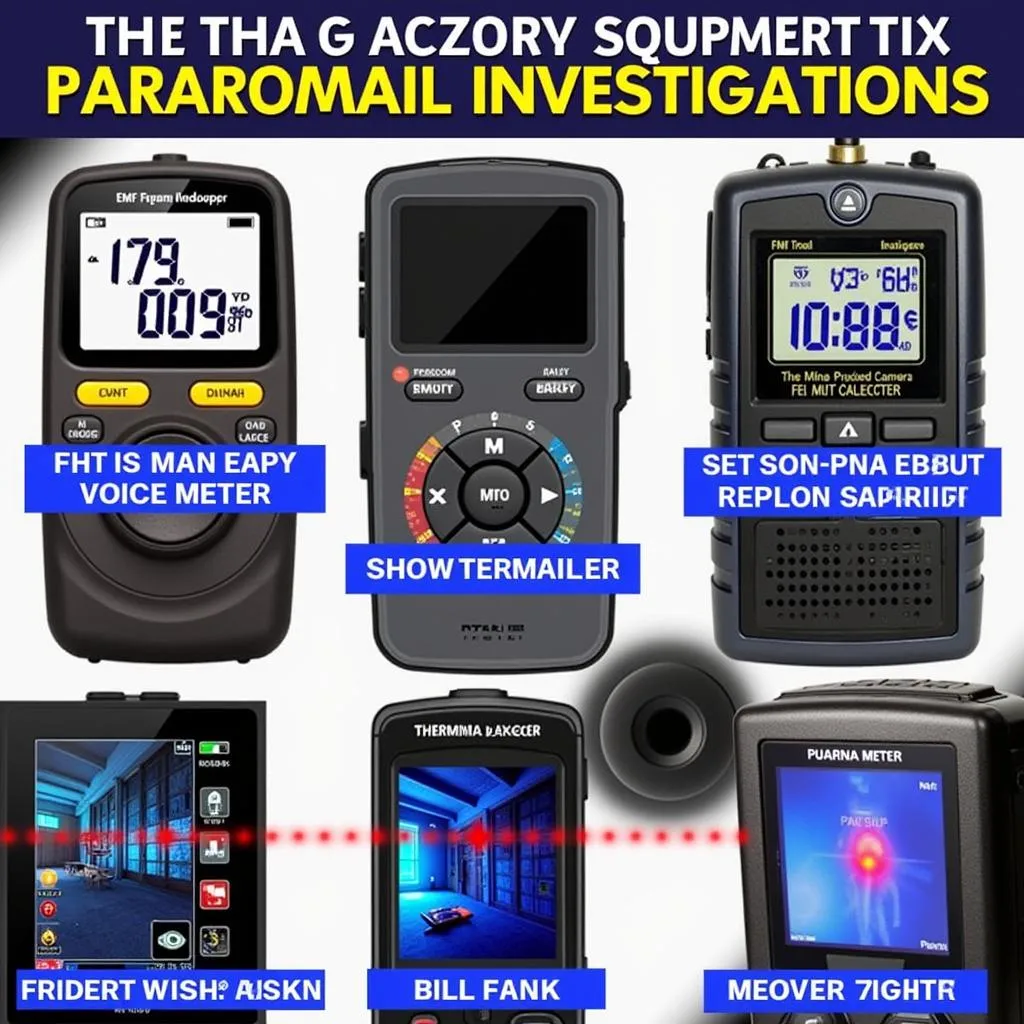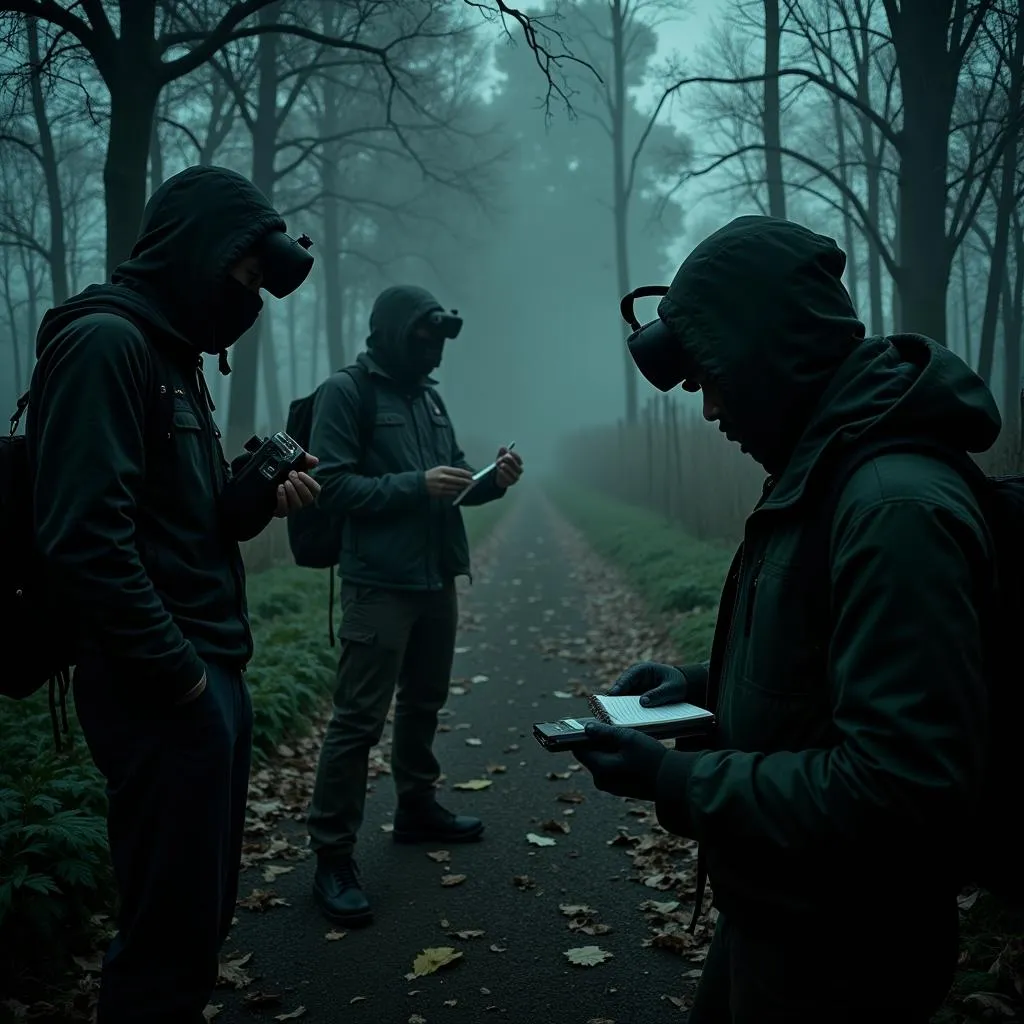The world of paranormal research, while steeped in mystery and intrigue, relies heavily on the crucial elements of Research And Planning. These components are essential for investigators, ensuring responsible and insightful explorations into the unknown.
 Essential Equipment for Paranormal Research
Essential Equipment for Paranormal Research
The Foundation: Meticulous Research
Thorough research forms the bedrock of any credible paranormal investigation. It’s akin to building a house – you wouldn’t start without a blueprint.
Delving into the History
Every location or phenomenon has a past. Researching historical records, local lore, and eyewitness accounts provides crucial context. Was the site of a tragic accident? Are there long-standing rumors of hauntings? This information helps investigators understand potential triggers for paranormal activity.
Utilizing Online Databases and Archives
The internet offers a wealth of resources. Websites dedicated to paranormal research, historical societies, and even newspaper archives can yield valuable data. Remember, a single detail, seemingly insignificant, can be the missing puzzle piece.
Strategic Planning: The Key to Success
With research complete, meticulous planning comes next. Think of it as charting a course through uncharted waters – a good plan helps avoid unnecessary risks.
Defining Objectives and Scope
What are the investigation’s goals? Are you seeking to document paranormal activity, debunk claims, or communicate with entities? Clearly defining the scope prevents mission creep and ensures a focused approach.
Equipment Checklist and Safety Protocols
Just as a scientist prepares their lab, paranormal investigators need the right tools:
- EMF Meters: Detect fluctuations in electromagnetic fields, often associated with paranormal activity.
- Voice Recorders: Capture electronic voice phenomena (EVPs), potential spirit voices inaudible to the human ear.
- Thermal Cameras: Identify cold spots, which might indicate a paranormal presence.
Safety protocols are paramount. Investigators should work in teams, maintain constant communication, and have an emergency plan in place.
The Investigative Process: A Calculated Approach
Research and planning culminate in the investigation itself. This is where theory meets practice.
Setting the Stage
Creating a controlled environment is essential for accurate data collection. This might involve:
- Minimizing external influences: Turning off electrical devices to reduce interference with sensitive equipment.
- Establishing a baseline: Taking initial readings with equipment to understand the location’s normal conditions.
Data Collection and Documentation
Throughout the investigation, meticulous documentation is crucial:
- Detailed notes: Time-stamped observations, equipment readings, and personal experiences.
- Audio and Video Recordings: Provide objective evidence of events.
- Photographs: Capture visual anomalies or potential evidence.
 Paranormal Investigators Documenting Evidence
Paranormal Investigators Documenting Evidence
Post-Investigation Analysis: Unveiling the Truth
The investigation doesn’t end when you leave the location. The real work begins with data analysis.
Reviewing and Correlating Data
This stage involves scrutinizing all collected information for patterns, anomalies, and potential explanations. Did EMF spikes coincide with temperature drops? Were EVPs captured in response to specific questions?
Drawing Conclusions and Further Research
Based on the evidence, investigators can draw conclusions. Did the investigation support the claims of paranormal activity? Were there logical explanations for the observed phenomena? Often, further research is necessary to explore new leads or unanswered questions.
Conclusion
Research and planning are the twin pillars of responsible and insightful paranormal investigation. By embracing a methodical approach, investigators navigate the unknown with a balance of curiosity and skepticism. This dedication to uncovering the truth ensures the integrity of paranormal research, pushing the boundaries of understanding while respecting the mysteries that lie beyond.
FAQs
1. Do I need to be a trained paranormal investigator to conduct research?
While formal training is beneficial, anyone can engage in research. Start with online resources, books, and local paranormal groups.
2. What are some common mistakes to avoid in paranormal research?
Jumping to conclusions without evidence, not controlling for environmental factors, and neglecting safety protocols are common pitfalls.
3. How can I contribute to the field of paranormal research?
Document your experiences, share your findings with reputable organizations, and approach investigations with an open but discerning mind.
4. What if I’m experiencing paranormal activity in my own home?
Document the events, research potential explanations, and consider contacting a reputable paranormal investigation team if needed.
5. Is paranormal research dangerous?
While not inherently dangerous, it’s important to prioritize safety. Always investigate in teams, communicate clearly, and have an emergency plan.
Need Assistance?
For further guidance on navigating the intricacies of paranormal research or assistance with your own investigations, don’t hesitate to reach out. Contact us at Phone Number: 0904826292, Email: [email protected], or visit us at Address: No. 31, Alley 142/7, P. Phú Viên, Bồ Đề, Long Biên, Hà Nội, Việt Nam. Our dedicated team is available 24/7 to provide support and answer your questions.
 Online Resources for Paranormal Enthusiasts
Online Resources for Paranormal Enthusiasts
Explore our website for more articles on various aspects of Paranormal Research and delve deeper into the unknown. Remember, the pursuit of knowledge is a journey best taken with thorough research and meticulous planning as your guides.